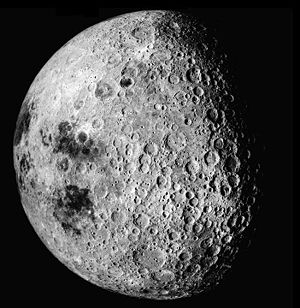by Larry
September, 20111 + 1 = 1?This is but the latest of a number of ideas concerning the anomalous far side of the Moon, but it is evidently an elegant and plausible one. In the hypothesis, both a larger moon and a second, much smaller moon, only about 1000 kilometers in diameter (roughly 600 miles) coalesced from the debris formed by a collision about four billion years ago between a Mars-sized planet and an early Earth. The gravitational forces then at play between the three bodies would have permitted the two moons to both orbit the Earth for an initial period of around 30 to 100 million years.
Meanwhile, tidal forces would have affected the moons' orbits, causing them to gradually move farther from Earth. This, in turn, would have caused the smaller moon's orbit to become unstable since, at about one-third our Moon's distance from the Earth, the Sun's gravitational field would have begun to significantly affect the dynamics between the three bodies. Just as a tight-rope walker can sustain her or his progress only so long as in good balance on the wire, a smaller moon's orbit independent of the larger moon's was possible only so long as additional forces had not altered the equilibrium between the original three entities. This stability may have persisted for tens of millions of years, however, long enough for the crusts of both moons to cool and harden. Finally, though, their orbits would have been almost the same, and a collision would have occurred. When this happened, it is speculated that the two moons did not impact one another the way asteroids or comets have typically hit the moon or Earth, at huge velocity with vast plumes and craters, but instead in relatively slow motion. It may have been more like a couple chunks of cheese hitting one another. After a collision that may have happened in minutes, over the next few hours gravitational forces would have "pancaked" the smaller moon's debris thinly across one side of the larger moon, mixing it with that moon's crust material in ways that created highlands which persist on the far side of the Moon today. Internally, the larger moon's still molten core would also have been pushed by the impact into the side of the moon opposite the collision. This would have meant that part of the resulting Moon, the visible side facing Earth, would have been more susceptible to alteration by later asteroid or other impacts, leaving the far side's collision-formed highlands, despite the intervening billions of years, relatively intact. While it may seem of little moment whether Earth once, for a few score millions of years, had a second moon, if it did and that moon's existence ended as is suggested here, it would have had large consequences for this planet's potential as an incubator for life. For one thing, there almost certainly would have been debris of the collision that would have fallen to Earth, affecting our own crust in incalculable ways but in a manner that surely left its mark in the types of continental drifts which later would develop. For another, our tides would have been quite different, and likely more complex, with two moons than with one. At times, with three orbs lined up just right, they might well have been so intense as to preclude the birth into being and the reproduction of tiny bits of living tissue. On the other hand, if not bolstered by the second moon's mass, the pull between Earth and the Moon might well not have been enough to nurture living things in their tidal pools in precisely the right way to allow for the gradual evolution of a few single celled aquatic forms into amphibious ones, ones with backbones, air breathing ones, land ones, etc., till in time there might emerge "all creatures large and small," including, not least perhaps, ourselves. Since there are a variety of untested hypotheses for the differences between the two sides of Luna, scientists are hopeful that more precise data from a just launched (on September 10) GRAIL mission, intended to give detailed info on the Moon's interior gravitational forces, will help pin down which, if any, of the ideas turn out to be correct. It is thought by some, however, that fresh samples of Moon rocks will be required to settle the matter. Primary Source: Early Earth May Have Had Two Moons. Richard Lovett in Nature News; 3 August 2011. |
